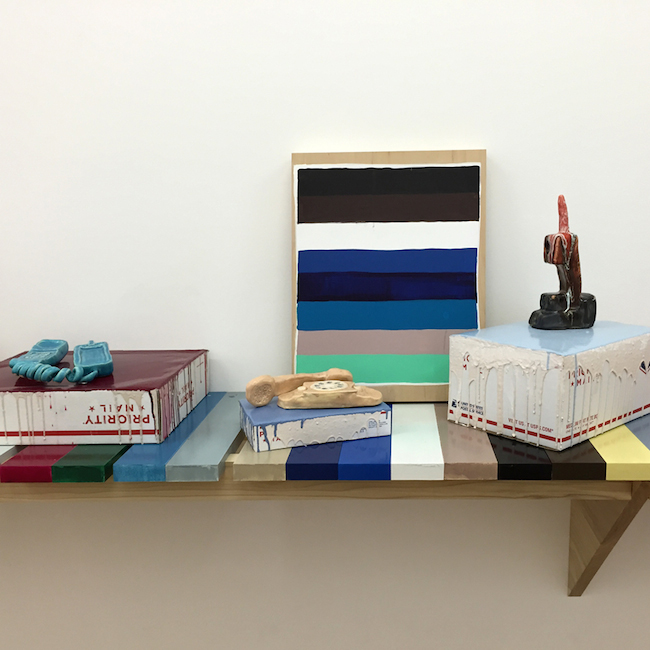Ceramic phones tested the relationships between painting, sculpture, design and memory last year at Pam Lins’ exhibition model model model at the Rachel Uffner Gallery (New York, April 19 – May 31, 2015). The phones look like they were pulled into this world from someone’s hazy memories about the phone that once adorned their office desk or kitchen counter.
There’s a throwback to the past in Lins’ choice to include vintage telephone models marketed to women (the “Princess” design) in the United States compared to Soviet telephone designs, but even these two disparate design sensibilities share a fate in that their best days are behind them. Even if they weren’t made of ceramic they’re all equally relics in the age of cell phones, as dead as the cultural forces that spawned them. “(Telephones) are nothing without their network,” writes art history professor Juliet Koss in her introduction to the exhibition.
“As Ronell wrote, the telephone ‘presupposes the existence of another telephone, somewhere, though … its singularity is what we think of when we say “telephone.” ‘ You may hold that special object, waiting for that call, but the phone you’re holding is a model. And at its heart lies a notion of scale: there are now more phones on earth than there are people, and your phone belongs as much to the global network as it does to you.
“What does it mean to craft these obsolete machine objects by hand, to cobble them together in clay, to paint them colors the Princess designers never dreamed of, to render them obdurate—and useless?”

Pam Lins, 2015, MDF shelves with desaturated GTO colors, USPS Flat Rate box, aqua resin, acrylic paint and ceramic model, 8 x 20 x 22 inches
Lins extends that idea to other objects. Koss writes:
The objects made by Lins—a Bell telephone, a VKhUTEMAS model, a table built to the specifications set out by Enzo Mari in his open-source manual Autoprogettazione of 1974—are at the same time models for some other form of artistic production: things beyond the categories of craft, art, design, sculpture, image, capitalist consumerism, or communist nostalgia. They, too, exist within a network. “An object’s status as a model depends more strongly on the judgment of the perceiving subject than does its status as an image,” Mahr insists. An image can be an image even without us; a model needs us to be there, engaging, taking it as a model, tracing it back, bringing it forward: picking up the cargo it transmits.

Pam Lins, 2015, MDF shelves with GTO colors, plaster and ceramic models, 18 x 20 x 22 inches
Lins reached into past to create models of telephones that are lost to us today. She snagged a few more abstract forms she saw in a picture of a Soviet-era workshop in Moscow. Writing for the New York Times, Martha Schwendener states:
“The other project relates to a specific photograph, viewable at the front desk: a grainy black-and-white image depicting a workshop at Vkhutemas, the state art academy founded in Moscow in 1920. The school employed avant-garde artists like Kazimir Malevich, Aleksandr Rodchenko and Vladimir Tatlin, and was intended to train a generation of artists to work in the new, utopian society. Ms. Lins has beautifully approximated in clay and wood the abstract forms and supporting platforms visible in the photograph.

Pam Lins’ recent solo exhibitions include The Tang Museum, Saratoga Springs, NY and The Suburban, Oak Park, IL, according to the gallery. She was also recently included in exhibitions at The Brooklyn Museum, Brooklyn, NY, CCS Bard Galleries, Annandale-on-Hudson, NY, and she was a participant in the 2014 Whitney Biennial. In 2013-2014, Lins held the David and Roberta Logie fellowship at the Radcliffe Institute for Advanced Study at Harvard University. She also received a Guggenheim Fellowship in 2008 and the Howard Foundation Fellowship from Brown University in 2007. Lins has held teaching positions at The Cooper Union, Bard College, and Princeton University. She lives and works in Brooklyn and holds a MFA from Hunter College.
Love contemporary ceramic art + design? Let us know in the comments.

Pam Lins, model, 2015, glazed ceramic, 7 1/4 x 8 x 7 1/2 inches

Pam Lins, model, 2015, glazed ceramic, 9 1/2 x 6 3/4 x 10 inches

Pam Lins, model, 2015, glazed ceramic, 9 1/4 x 6 1/2 x 6 3/4 inches

Pam Lins, model, 2015, glazed ceramic, 13 1/4 x 5 x 3 1/2 inches

Pam Lins, SketchUp Enzo Mari Model, 2015, gesso and acrylic on panel, 20 x 18 inches





Add your valued opinion to this post.